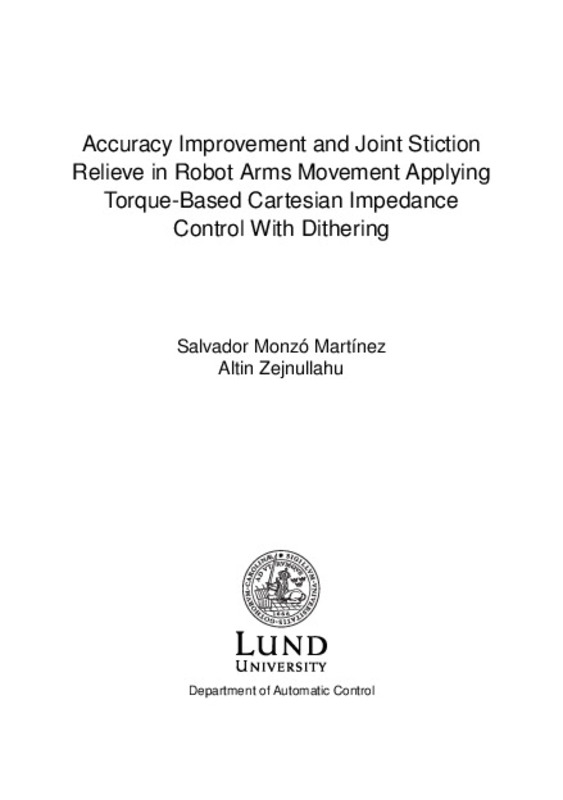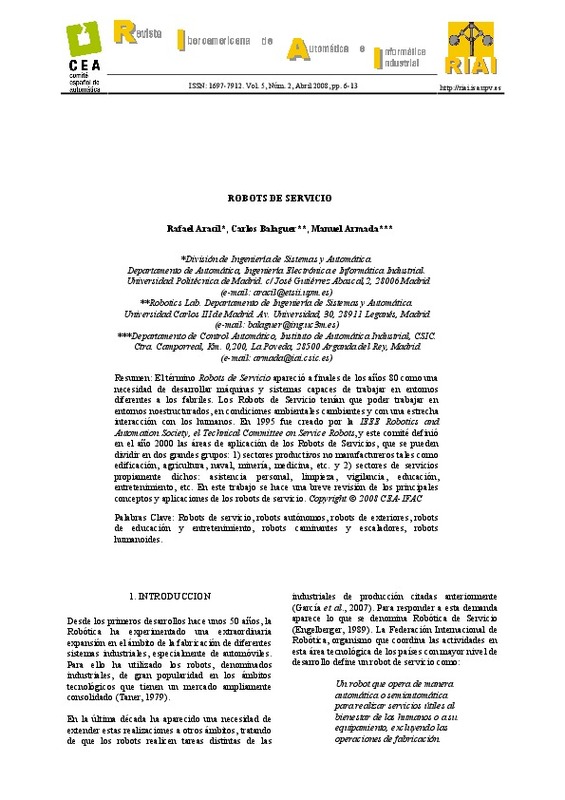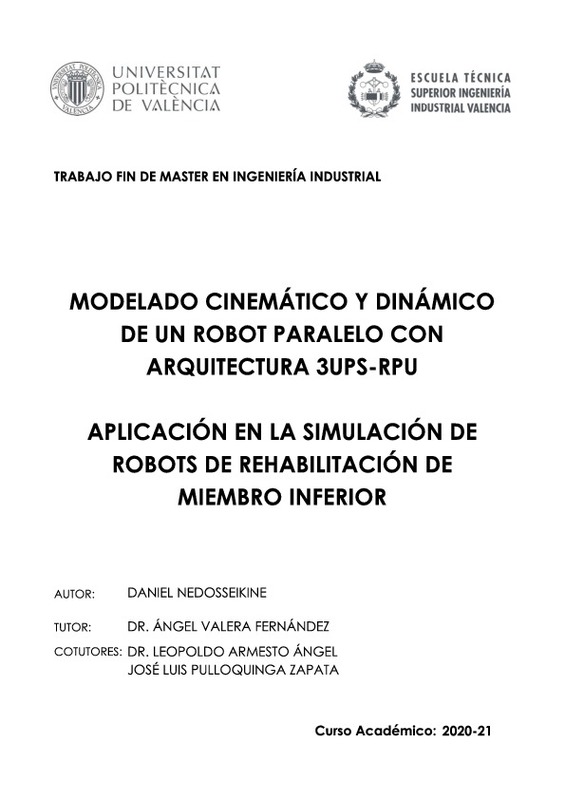JavaScript is disabled for your browser. Some features of this site may not work without it.
Buscar en RiuNet
Listar
Mi cuenta
Estadísticas
Ayuda RiuNet
Admin. UPV
Accuracy Improvement and Joint Stiction Relieve in Robot Arms Movement Applying Torque-Based Cartesian Impedance Control With Dithering
Mostrar el registro sencillo del ítem
Ficheros en el ítem
| dc.contributor.advisor | Vallés Miquel, Marina
|
es_ES |
| dc.contributor.author | Monzó Martínez, Salvador
|
es_ES |
| dc.date.accessioned | 2023-09-26T13:09:49Z | |
| dc.date.available | 2023-09-26T13:09:49Z | |
| dc.date.created | 2023-07-21 | |
| dc.date.issued | 2023-09-26 | es_ES |
| dc.identifier.uri | http://hdl.handle.net/10251/197127 | |
| dc.description.abstract | [ES] Los robots están hoy en día presentes y son esenciales en una amplia gama de aplicaciones, y los brazos robóticos en particular son capaces de realizar diversas tareas como inspección, manipulación de materiales y soldadura. Pueden clasificarse en varios tipos, según su estructura y finalidad. Este proyecto se centra en dos brazos robóticos colaborativos, un tipo diseñado para trabajar en presencia de interacción humana. Ambos poseen un manipulador en el extremo del brazo, conocido como efector final, que normalmente realiza las tareas y se encarga de seguir las trayectorias instruidas por el controlador. Uno de los retos a los que se enfrentan los brazos robóticos es la fricción estática en las articulaciones, también conocida como "stiction". Este fenómeno ocurre generalmente en regímenes de baja velocidad, teniendo su componente principal prevista a velocidad cero, y puede afectar al movimiento del robot y, por tanto, a su precisión. Durante este trabajo de tesis se caracterizará la fricción estática a través de diferentes aproximaciones y se mitigará su impacto aplicando una técnica conocida como dithering. El dithering consiste en añadir una señal periódica, en este caso una onda sinusoidal, al controlador del robot para reducir el efecto de la fricción estática. Se puede construir una señal de dithering particular para cada una de las articulaciones del robot, ya que su dinámica también es diferente entre ellas. Se han diseñado dos enfoques para caracterizar la fricción estática. El primer enfoque implica la identificación de la dinámica del robot, mientras que el segundo, denominado Experimento de Articulación Única (EAU), es un método empírico iterativo en el que el brazo del robot realiza movimientos individualizados para cada articulación. Posteriormente, se construyeron señales de dithering tras caracterizar las bandas de fricción estática, y se aplicaron a diferentes experimentos de movimiento. En primer lugar, se mejoró el EAU reduciendo el par mínimo necesario para superar la fricción estática y, al mismo tiempo, se utilizó este procedimiento para obtener los parámetros óptimos de las señales de dithering de las articulaciones. Por último, aplicando estas señales de dithering óptimas al controlador, también se redujeron las desviaciones en las trayectorias, lo que se tradujo en una mejora de la precisión. | es_ES |
| dc.description.abstract | [EN] Robots are nowadays present and essential in a wide range of applications, and robot arms in particular are capable of performing various tasks such as inspection, material handling, and welding. They can be classified into several types, depending on their structure and purpose. This project focuses on two collaborative robot arms, a type that is designed to work in the presence of human interaction. They both possess a manipulator at the end of the arm known as end effector, which normally realizes the tasks and is responsible for following trajectories instructed by the controller. One of the challenges faced by robot arms is static friction in the joints, also known as stiction. This phenomenon generally occurs in low-speed regimes, having its main component expected at zero velocity, and might affect the robot¿s motion and therefore its accuracy. During this thesis work, stiction will be characterized through different approaches and its impact will be mitigated by applying a technique known as dithering. Dithering consists of adding a periodic signal, in this case a sinusoidal wave, to the robot controller in order to reduce the stiction effect. A particular dithering signal can be built for each of the robot joints since their dynamics are also different between them. Two approaches were designed to characterize the stiction. The first approach involves the identification of the robot dynamics, while the second approach, referred to as the Single Joint Experiment (SJE), is an empirical iterative method in which the robot arm conducts individualized motions for each joint. Subsequently, dithering signals were built after characterizing the stiction bands, and applied to different motion experiments. The SJE was first improved by reducing the minimum torque needed to surpass stiction, and at the same time this procedure was used to obtain the optimal parameters for the joints¿ dithering signals. Finally, applying these optimal dithering signals to the controller, the deviations in the trajectories were also reduced, resulting in improved accuracy. | es_ES |
| dc.format.extent | 96 | es_ES |
| dc.language | Inglés | es_ES |
| dc.publisher | Universitat Politècnica de València | es_ES |
| dc.rights | Reserva de todos los derechos | es_ES |
| dc.subject | Brazo robot | es_ES |
| dc.subject | Robot colaborativo | es_ES |
| dc.subject | Articulación | es_ES |
| dc.subject | Dithering | es_ES |
| dc.subject | Fricción estática | es_ES |
| dc.subject | Stiction | es_ES |
| dc.subject | Control de impedancia Cartesiana | es_ES |
| dc.subject | Robot arm | es_ES |
| dc.subject | Collaborative robot | es_ES |
| dc.subject | Joint | es_ES |
| dc.subject | Static friction | es_ES |
| dc.subject | Cartesian impedance control | es_ES |
| dc.subject.classification | INGENIERIA DE SISTEMAS Y AUTOMATICA | es_ES |
| dc.subject.other | Máster Universitario en Ingeniería Industrial-Màster Universitari en Enginyeria Industrial | es_ES |
| dc.title | Accuracy Improvement and Joint Stiction Relieve in Robot Arms Movement Applying Torque-Based Cartesian Impedance Control With Dithering | es_ES |
| dc.title.alternative | Desarrollo de señales para la mejora de precisión y reducción de fricción estática en las articulaciones de brazos robóticos aplicando control de impedancia Cartesiana | es_ES |
| dc.title.alternative | Desenvolupament de senyals per a la millora de precisió i reducció de fricció estàtica en les articulacions de braços robòtics aplicant control d'impedància Cartesiana | es_ES |
| dc.type | Tesis de máster | es_ES |
| dc.rights.accessRights | Abierto | es_ES |
| dc.contributor.affiliation | Universitat Politècnica de València. Departamento de Ingeniería de Sistemas y Automática - Departament d'Enginyeria de Sistemes i Automàtica | es_ES |
| dc.contributor.affiliation | Universitat Politècnica de València. Escuela Técnica Superior de Ingenieros Industriales - Escola Tècnica Superior d'Enginyers Industrials | es_ES |
| dc.description.bibliographicCitation | Monzó Martínez, S. (2023). Accuracy Improvement and Joint Stiction Relieve in Robot Arms Movement Applying Torque-Based Cartesian Impedance Control With Dithering. Universitat Politècnica de València. http://hdl.handle.net/10251/197127 | es_ES |
| dc.description.accrualMethod | TFGM | es_ES |
| dc.relation.pasarela | TFGM\158734 | es_ES |
Este ítem aparece en la(s) siguiente(s) colección(ones)
-
ETSII - Trabajos académicos [9887]
Escuela Técnica Superior de Ingenieros Industriales









